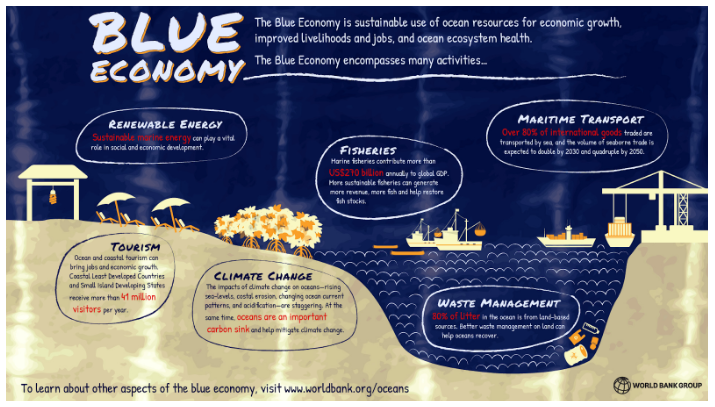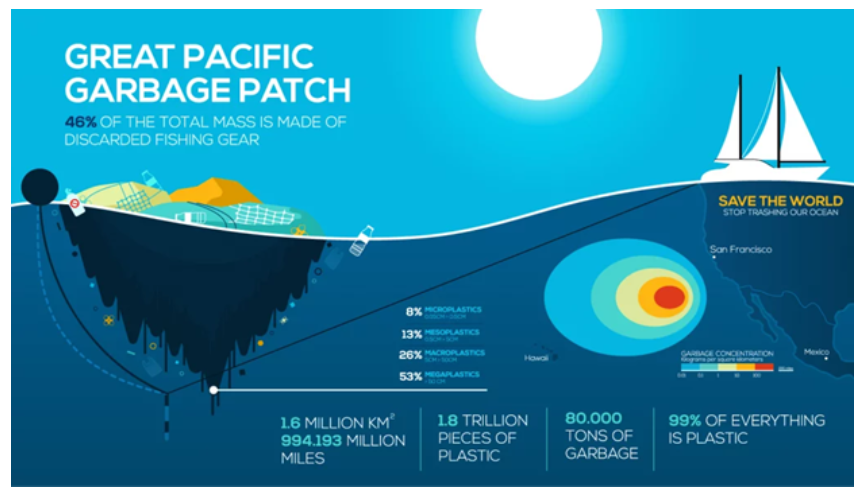24 Feb to 10 Mar, 2024
BLACK CARBON FOOTPRINT OF HUMAN PRESENCE IN ANTARCTICA
Why in news? : Black carbon (BC) from fossil fuel and biomass combustion darkens the snow and makes it melt sooner. The BC footprint of research activities and tourism in Antarctica has likely increased as human presence in the continent has surged in recent decades.
About :
Introduction:
In an era where environmental consciousness is of paramount importance, the black carbon footprint emerges as a complex and multi-dimensional challenge. Black carbon, commonly referred to as soot, is a fine particulate matter produced from incomplete combustion of fossil fuels, biomass, and other organic materials. It is a significant contributor to global warming, air pollution, and adverse health effects.
Natural causes of Black Carbon :
- Wildfires: Wildfires inject large amounts of black carbon (BC) particles into the atmosphere, which can reach the lowermost stratosphere (LMS) and cause strong radiative forcing. Black Carbon Emissions from the Siberian Fires in 2019 impacting the entire Arctic region.
- Volcanic Eruptions: Black carbon emissions due to volcanic eruption of Mount St. Helens in the United States in 1980 dispersed over long distances by wind patterns.
- Biomass Burning: Natural events like lightning strikes can ignite biomass, such as forests or grasslands, leading to the release of black carbon and other smoke particles. Eg Amazon rain forest fires in South America.
- Vegetation Decay: Black carbon emissions due to vegetation decay is found in peatlands. A notable example is the draining and degradation of peatlands in Southeast Asia, particularly in Indonesia
- Dust Storms: Wind-blown dust particles can mix with soot and become black carbon aerosols. One notable example is the "Asian Dust" phenomenon, also known as the "Yellow Dust" or "Yellow Sand," which occurs in East Asia.
Anthropogenic causes of Black Carbon:
- Fossil Fuel Combustion: According to the USA, fossil fuel combustion accounted for approximately 25% of the black carbon emissions in the country.
- Transportation: In 2016, the Indian Institute of Technology (IIT) Delhi conducted a study and found that transportation was a major source of black carbon emissions in Delhi.
- Waste Incineration: Burning of waste in open dumps or poorly controlled incineration facilities can emit black carbon and other pollutants.
- Residential Energy Use: In the Himalayan state of Uttarakhand and Himachal, many households rely on traditional cooking stoves that burn solid fuels like wood, agricultural residues, and dung for their daily cooking needs, significantly contributing in black carbon emissions.
- Deforestation and Land Use Changes: Researchers from the Woods Hole Research Center and the University of California, Irvine, found that deforestation and associated land use changes were responsible for significant black carbon emissions in the Amazon basin.
Significant Impacts of Black Carbon:
- Human Health : Black carbon is a major component of fine particulate matter (PM2.5). Inhalation of PM2.5 can lead to respiratory and cardiovascular problems, particularly in vulnerable populations such as children and the elderly.
- Climate Change: Black absorbs sunlight and contributes to regional and global warming, influencing the Earth's energy balance and climate patterns. As black carbon settles on the Himalayan glaciers, it accelerates their melting rates.
- Agriculture and Food Security: Black carbon in the atmosphere can reduce sunlight reaching crops, leading to lower photosynthesis rates and potentially reducing crop yields. Crops like rice, wheat, and maize can be particularly affected, impacting food production and availability. Black carbon can alter regional weather patterns, including the timing and intensity of monsoon rains.
- Ecosystems and Biodiversity: Black carbon deposition in Arctic soils affects the temperature and moisture regimes of the soil. This, in turn, can alter the microbial communities living in the soil, which play critical roles in nutrient cycling.
- Tourism and Industry : Poor air quality resulting from black carbon emissions can deter tourists from visiting certain areas, impacting local tourism-based economies. Study finds an increased concentration of black carbon in Gangotri region during tourist seasons.
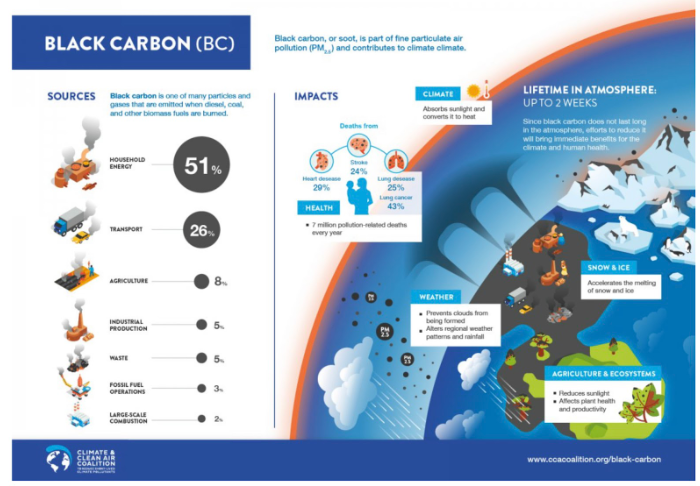
|
CASE STUDY : ARCTIC BLACK CARBON The Arctic has become a hotspot for black carbon research as it is playing a crucial role in warming and the strong heating effect . The presence of black carbon on ice and snow surfaces reduces their albedo, causing them to absorb more sunlight. This process, known as "Arctic Amplification," accelerates ice melt, leading to the shrinking of Arctic sea ice and glaciers. Study found a direct correlation between black carbon deposition and glacier retreat rates . Black carbon can darken the surface of permafrost, increasing heat absorption and accelerating permafrost thaw. Thawing permafrost releases greenhouse gasses, further contributing to global warming. Reduced sea ice and changes in sea ice dynamics can also affect the timing and availability of food for Arctic marine animals. Black carbon aerosols can alter atmospheric circulation patterns and contribute to shifts in weather patterns with implications for local communities dependent on traditional activities like hunting and fishing. |
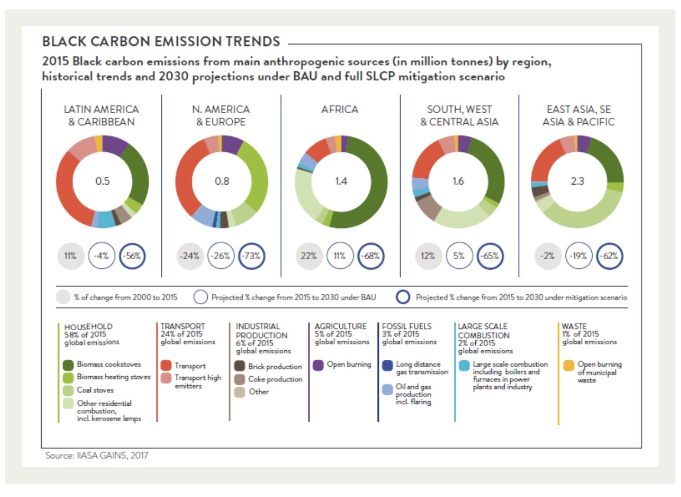
How Black Carbon Disturbs the Heat Budget of the Earth ?
- Absorption of Solar radiation: Black carbon particles when released into the atmosphere, intercept solar radiation and convert it into heat. This process reduces the albedo , warms the surrounding air and contributes to the overall heating of the atmosphere.
- Disruption of Atmospheric Stability: Black carbon in the atmosphere can alter the vertical temperature profile, reducing the stability of the atmosphere. This can impact cloud formation and weather systems, leading to changes in precipitation patterns and atmospheric circulation.
- Affecting Clouds: Black carbon particles can act as cloud condensation nuclei, influencing the formation and properties of clouds. This can lead to changes in cloud behavior, potentially affecting cloud cover and cloud lifetimes, and ultimately impacting the Earth's energy balance.
- Affecting Ocean Circulation : Melting of ice due to black carbon deposition can lead to changes in ocean circulation patterns. As fresh meltwater enters the ocean, it can disrupt the balance of salinity and density, affecting ocean currents and heat distribution.
- Ocean Warming: Black carbon contributes to the heating of the atmosphere when it absorbs sunlight. As the atmosphere warms, it can transfer some of this heat to the ocean through increased evaporation and ocean-atmosphere heat exchange.
Activities undertaken by selected GEF( Global Environment Facility ) Implementing Agencies and other international organizations towards mitigating Black Carbon.
|
GEF Implementing Agency |
Activity |
|
World Bank |
• Engaged in reducing BC emissions from the brick sector in South Asia • Assessed potential BC mitigation approaches to reduce impacts on cryosphere regions |
|
United Nations Environment Programme (UNEP) |
• Hosts the Partnership for Clean Fuels and Vehicles.
|
|
United Nations Industrial Development Organization (UNIDO) |
|
SOLUTIONS TO MITIGATE THE EMISSIONS OF BLACK CARBON
- Cleaner Energy Sources: Transitioning from fossil fuels to cleaner energy sources, such as renewable energy (solar, wind, hydroelectric) and natural gas, can significantly reduce black carbon emissions from power generation, industrial processes, and residential heating. India's initiative to switch from BS IV to BS VI engine vehicles is commendable .
- Improved Cooking Technologies: Promoting the use of improved cookstoves and clean fuels (e.g., LPG, biogas) for cooking can help reduce black carbon emissions from traditional biomass burning in households. The Government of India introduced PMUY ( Pradhan Mantri Ujjawala Yojana ) offers BPL households a cash contribution of Rs 1600 for each LPG connection.
- Advanced Emission Control Technologies: Installing and maintaining advanced emission control devices, such as particulate filters and scrubbers, can help capture black carbon and other pollutants from exhaust gases. WAYU (Wind Augmentation PurifYing Unit) was developed to address air pollution at traffic intersections and dense traffic zones.
- International Cooperation: Addressing black carbon emissions requires collaboration between countries, especially for transboundary pollution. International agreements and partnerships can support collective efforts to mitigate black carbon emissions.
Conclusion
- The measures to prevent black carbon emissions can reduce near-term warming of the climate, increase crop yields and prevent premature deaths.
- Black carbon’s short atmospheric lifetime, combined with its strong warming potential, means that targeted strategies to reduce emissions can provide climate and health benefits within a relatively short period of time.
Source : https://www.nature.com/articles/s41467-022-28560-w
https://ui.adsabs.harvard.edu/abs/2022NatCo..13..984C/abstract
Where to use ?
Paper I ( Geography Optional ) : Global Climatic change, Role and response of man in climatic changes
HIMALAYAS MORE PRONE TO EXTREME WEATHER EVENTS
Why in news : Global warming is reshaping the world’s highest and youngest mountain range and its interaction with the region’s weather systems.
About :
How shifts in weather pattern increase the frequency of Extreme events ?
- Shift in Monsoon patterns : Changes in the southwest monsoon patterns are becoming more common, especially over the Indo-Gangetic plain, rather than the southern parts of the subcontinent. Now, the dry and semi-dry western parts of India are experiencing more rainfall than usual, while the eastern and coastal regions are getting less rain, showing a switch from the usual rain patterns.
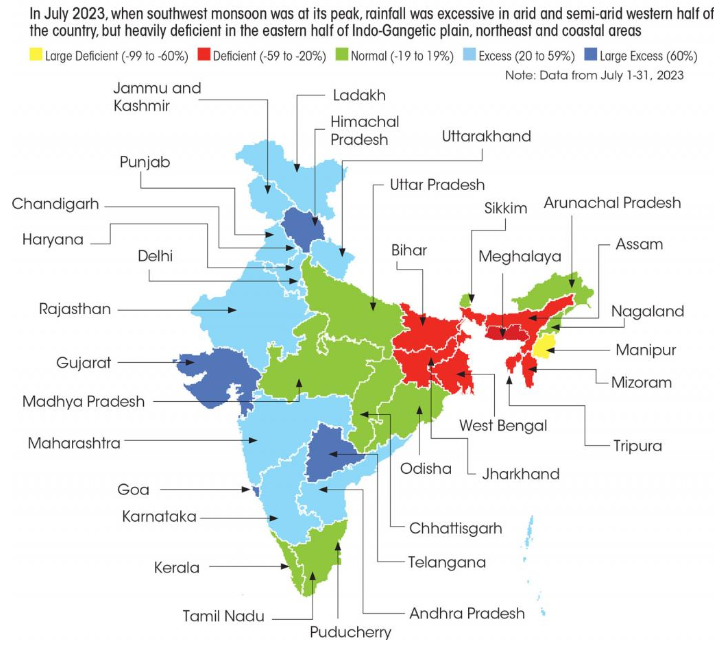
- Warming of the Arabian Sea : The top layer of the Arabian Sea has gotten unusually warm, causing more water to evaporate and possibly changing how the southwest monsoon acts. This increase in temperature has also led to more cyclones in the Arabian Sea, with some hitting the west coast of India.
- Increase in Cyclonic Activity : From 2001 to 2019, there was a 50% rise in the number of cyclones in this area, and about half of them weaken and disappear before reaching land.
- Cloud burst and extreme events : Cloudbursts are a unique type of rain that's much more intense than regular showers. Normally, raindrops are about 2 mm wide, but during severe thunderstorms and cloudbursts, they can grow to 4-6 mm. These larger, heavier drops fall faster and can cause landslides because of their strong impact.
- The frequency of thunderstorms, cloudbursts, and hailstorms has gone up significantly. While there were only 2 to 4 such events each year from 1970 to 2010, Himachal Pradesh saw as many as 53 in 2023 alone.
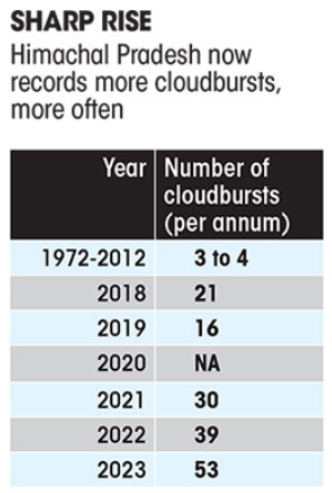
- Glaciers melting : The Himalayas are getting warmer, causing glaciers to melt faster and create glacial lakes.
- More frequent and intense cloudbursts make these lakes overflow or break their banks. This causes floods that lead to loss of life and damage to properties downstream.
- In areas like Uttarakhand and east of Himachal Pradesh, the count of glacial lakes rose from 127 in 2005 to 365 in 2015.
- The Himalayas have seen over 40% of their ice melt away, and it's likely to keep melting. By the century's end, we might lose up to 75% of the ice. This melting is changing where plants grow, how farming is done, and the availability of water in the area.
Adaptation Measures to Tackle the Impact of Climate Change
- Urgent need is to improve glaciers monitoring and early warning systems for landslides and glacial lake outbursts.
- Cut down GHG emissions and shift to renewable energy sources to mitigate effects of global warming .
- Adopt sustainable construction methods activities in Himalayan region to withstand any calamity . Following can be the steps
- Delineate the zones based on slope, drainage and vegetation cover to minimize risk associated with unstable terrain .
- It is important to identify vulnerable areas because of increased frequency of extreme events
- Projects like building dams for hydroelectric power can harm the environment in mountain areas. Rules need to be framed to protect forests, keep rivers from changing course, and preserve different kinds of plants and animals.
- To improve the ability of people in mountains to adapt, we should strengthen public services and infrastructure and focus on long-term, community-supported solutions.
Government Initiatives Related to the Himalaya
- National Mission to Protect the Himalayan Ecosystem (2010):This mission involves 11 states, including Himachal Pradesh, Uttarakhand, Sikkim, all states in the northeast, and West Bengal, plus two Union Territories: Jammu & Kashmir and Ladakh. It's a part of the National Action Plan to tackle climate change, which includes eight different missions.
- Indian Himalayas Climate Adaptation Programme (IHCAP):This program is designed to help vulnerable communities in the Indian Himalayas become more resilient. It focuses on improving the knowledge and abilities of Indian organizations in climate science, especially in studying glaciers.
- SECURE Himalaya Project: This project is part of a worldwide effort to conserve wildlife and prevent crimes that threaten sustainable development. It's supported by the Global Environment Facility (GEF) and aims to ensure the sustainable use of mountain grasslands and forests in the high Himalayas.
- Mishra Committee Report 1976: This report, named after MC Mishra, who was the commissioner of Garhwal in what used to be Uttar Pradesh, explored the issue of land sinking in Joshimath. It suggested limiting heavy construction, blasting, digging for road repairs, and cutting down trees in the area.
Source :
https://www.downtoearth.org.in/news/climate-change/distinct-disquiet-in-the-himalayas-94664
Where to use :
Paper II ( Geography optional ) : Climate change and Physiography
Paper III ( General Studies ) : Global warming and its effects
POTENTIAL OF LAKSHADWEEP
Why in news : Lakshadweep, India’s smallest Union Territory (UT), due to its proximity to international shipping routes, has the potential to become a logistics hub and a remarkable tourist destination of India.
About :
Tourism and Logistics Potential of Lakshadweep
- Tourism : Lakshadweep's untouched beaches, coral reefs, and crystal-clear waters make it an extraordinary place for tourists. By developing the right facilities and following sustainable tourism methods, Lakshadweep has the potential to be a top destination for travelers.
- Trade and Logistics : Located close to major international shipping lanes, Lakshadweep has the opportunity to emerge as a key center for logistics.
- Its nearness to the coastal city of Mangaluru, which has a significant port, opens up possibilities for trade partnerships and handling cargo. Many of Lakshadweep's islands are actually closer to Mangaluru, and the islanders have depended on it for their everyday necessities for hundreds of years, reflecting a long-standing trade relationship.
- With plans to enhance port connections and infrastructure, Lakshadweep could streamline trade processes, benefiting both the local community and the wider regional economy.
- Regional Growth: The plans for Lakshadweep's development mentioned in the Interim Budget for 2024-25 are set to help the islands and also boost growth in nearby places like Mangaluru.
- The Union Finance Minister announced during the Budget presentation that there would be projects to improve ports, tourism facilities, and other services on Indian islands like Lakshadweep, aiming to increase interest in local tourism. Better transport links, along with new cruise paths, could enhance tourism and business in Lakshadweep and the surrounding areas.
- Ecological Significance: Lakshadweep being a protected area highlights its environmental importance. Recommendations to have cruise ships anchor offshore rather than constructing big facilities on the islands show a dedication to eco-friendly measures.
Concerns Related to Development in Lakshadweep
- Environmental Concerns: The islands' unique environment, including the coral reefs and sea life, could be harmed by building projects, pollution, and more people coming. To protect these areas, it's important to follow eco-friendly development methods and strict rules.
- Cultural Effects: The traditional lifestyles and cultural values of the people living in Lakshadweep might be threatened by fast-paced development and more tourists.
- Infrastructure Needs: There's a big need for better infrastructure like roads, places to stay, and medical services to support tourism and business in Lakshadweep. Building these facilities without harming the islands' natural and cultural beauty needs careful planning and investment.
- Safety Issues: Due to Lakshadweep's location near busy sea routes and its status as a protected area, there are safety worries. Making sure the area is secure while also encouraging tourism and business will take a joint effort from various government bodies and groups.
- Involving the Community: It's very important to work with the people living in Lakshadweep when planning and carrying out development projects. Making sure development benefits everyone fairly and listening to the community's concerns is key to building support and maintaining harmony.
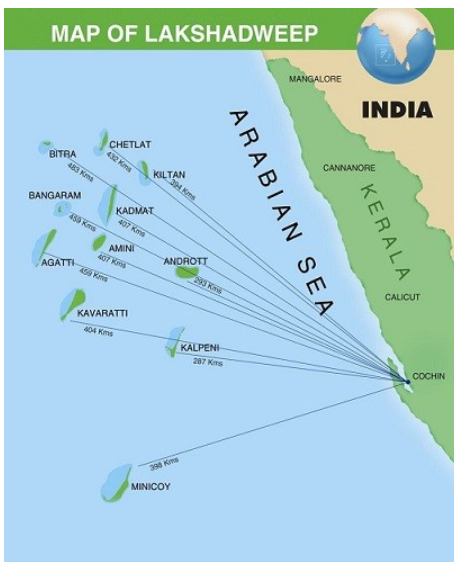
Source :
Where to use ?
Paper II ( Geography Optional ): Regional Planning, Development of Isalnds
BioTRIG
BioTRIG : It is a new waste management technology based on the pyrolysis system.
It works by sealing the waste inside an oxygen-free chamber and heating it above 400 degrees Celsius. In the study, the researchers outlined that three products of pyrolysis — bio-oil, syngas and biochar fertiliser — could help rural Indians live healthier and greener lives. A recent study has claimed that BioTRIG, a new waste management technology could help rural Indians
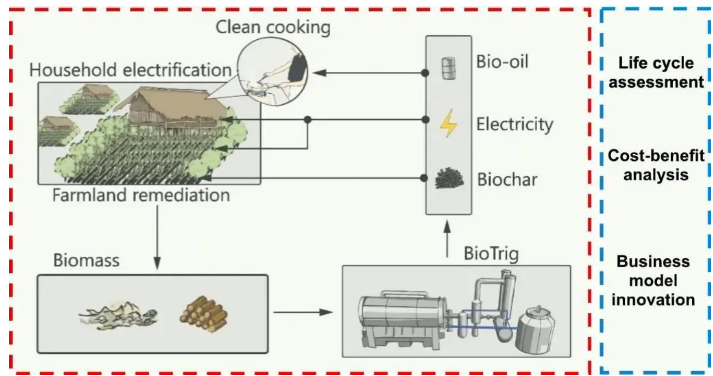
Ecocide - Edukemy Current Affairs
Ecocide : “Ecocide” is a term used to describe extensive and severe environmental damage or destruction, often as a result of human activities. It refers to actions or processes that cause widespread harm to ecosystems, biodiversity, and the natural environment on a scale that significantly disrupts the balance of nature and poses a threat to life on Earth. While the term “ecocide” is not a universally recognized legal concept, it has gained attention in discussions about environmental law and international criminal law. Recently , the Federal Parliament of Belgium has made history by becoming the first country in the European Continent to recognise ‘ecocide’ as a national as well as an international crime.
Stratospheric Aerosol Intervention
Stratospheric Aerosol Intervention : It is a geoengineering or climate engineering approach that uses tiny reflective particles or aerosols to reflect sunlight into space in order to cool the planet and reverse or stop global warming. It aims to mimic the cooling effects of volcanic eruptions by injecting sulfur dioxide (SO2) directly into the stratosphere, where it forms sunlight-reflecting sulfate aerosols. A recent study looked at the impact of stratospheric aerosol intervention (SAI) in mitigating global warming effects in West Asia (also known as Middle East) and North Africa (MENA).
Crepuscular
Crepuscular : Crepuscular animals are active at dawn and dusk to avoid predators. They are different from diurnal and nocturnal animals, which are active during daylight and darkness, respectively. Cheetahs are considered "crepuscular" hunters, meaning they hunt at sunrise and sunset.
Euryhaline
Euryhaline : Euryhaline organisms are organisms that can tolerate a wide range of salinities. They can live in a variety of habitats, including fresh water, brackish water, salt water, salt marshes, and high intertidal pools. Euryhaline organisms have a special mechanism called osmoregulation that helps them maintain the salt balance in their bodies.
GREAT BARRIER REEF CORAL BLEACHING
In 2016, the Great Barrier Reef (GBR) experienced the most severe coral bleaching in recorded history, yet, as in previous 1998 and 2002 events, the severity and spatial extent of coral bleaching were variable. Cyclonic activity mitigated warming effects in the southern GBR, meaning corals in this region were predicted to bleach less; as a result, southern reef areas received little attention. Surveys of 14 reefs revealed paling of coral colonies at every site. A total of 21% of living coral, primarily Pocillopora and branching Acropora, was affected. Findings suggest that southern reefs were affected by warming, although significantly less than in the north.
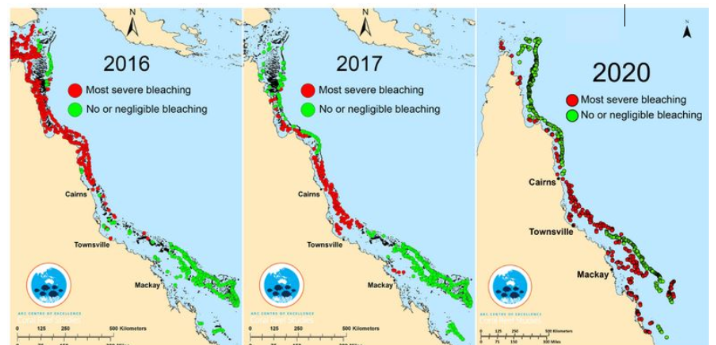
Source :
Paper I ( Geography optional ): Coral reefs and bleaching
Paper III ( General Studies ) : Climate change and Global warming
Places in news - Amrabad Tiger Reserve
1. Amrabad Tiger Reserve
Why in news : Recently, it was found that the Amrabad Tiger Reserve (ATR) is facing challenges such as understaffing and financial constraints.
- Amrabad is the second-largest Tiger Reserve in terms of core area.
- It is also the sixth largest in terms of total area among 51 Tiger Reserves in India.
- It is located in the Nagarkurnool and Nalgonda districts in the southern part of Telangana.
- The hilly terrain of this Tiger Reserve, with deep valleys and gorges, forms the catchment of the Krishna River.
- Approx. : Nalgonda
2. Kali tiger Reserve
Why in news : Recently, 40 spotted deer (axis axis) have been translocated from Chamarajendra Zoological Gardens (Mysuru Zoo) to Panasoli range of Kali Tiger Reserve (KTR) in Dandeli forest, Uttara Kannada district.
- Kali Tiger Reserve, earlier known as Dandeli-Anshi Tiger Reserve, is located in the central portion of the Uttara Kannada (North Canara) district of Karnataka state.
- The Tiger Reserve comprises two important protected areas of the region viz., Dandeli Wildlife Sanctuary (475.018 Km²) and Anshi National Park (339.866 Km²).
- The Kali River flows through the tiger reserve and is the lifeline of the ecosystem.
- Approx : Uttar Kannada
3. Chandragiri river
Why in news : Conservationists from the University of Portsmouth have recently uncovered the nesting site of the “secretive” Cantor’s giant softshell turtle on the banks of the Chandragiri River in Kerala.
- The Chandragiri River or Payaswini also known as the Perumpuzha River, is the longest river in Kasaragod district, Kerala, India.
- The river is a historical treasure of Chemnad. It was named after the Mauryan emperor Chandragupta Maurya.
- The river originates in the Talakaveri Wildlife Sanctuary in the Western Ghats of Kodagu district, Karnataka.
- Chemnad is considered as the Land Of Chandragiri.
4. Palghar
Why in news : A fisherman from Maharashtra’s Palghar district was attacked by a bull shark in the Vaitarna river.
- Palghar is a town in the Konkan division of Maharashtra state, India and a municipal council.
- Palghar lies on the Western Line of the Mumbai Suburban Railway in the busy Mumbai-Ahmedabad rail corridor.
- Vadval is the most numerous community present in Palghar. They are said to be the descendants of Yadava dynasty of Devagiri
- The Koli (fishermen) community of Palghar is a reminder of the city's links with the Arabian sea.
- Approx : Mahabaleshwar
5. Ponmudi hills
Why in news : A team of researchers has recently discovered a new species of damselfly at the Ponmudi hills in Thiruvananthapuram district of Kerala.
- Ponmudi translates to ‘Golden Hill’ or ‘Golden Peak’ is located in the state of Kerala
- It is located in the state of Kerala. It is part of the Western Ghats mountain range.
- The hills are a part of the Agasthyamalai landscape, at the southernmost tip of the Western Ghats.
- These hills are biodiversity-rich, and recently the third species of damselfly has been discovered from this region.
- Approx : Thiruvananthapuram
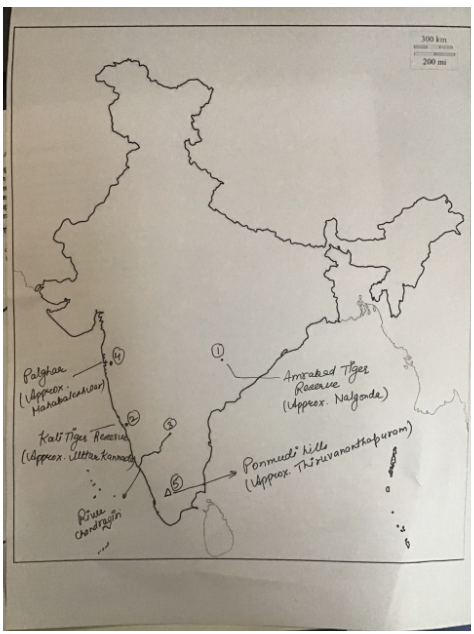
Fortnightly KOSMOS MCQ Practice
Q1. With reference to Atmospheric River, consider the following statements:
- The atmospheric river consists of a prolonged, slender stream of air saturated with moisture, which conveys substantial quantities of water vapor from tropical regions towards higher latitudes.
- The "Pineapple Express" is a notable instance of atmospheric river events, known for delivering intense precipitation to the eastern United States, especially affecting New York.
Which of the statements given above is/are correct?
- 1 only
- 2 only
- Both 1 and 2
- None of the above
Q2. With reference to the Water (Prevention and Control of Pollution) Amendment Bill, 2024, consider the following statements:
- It emphasizes the decriminalization of minor infractions pertaining to water pollution, reducing concerns over incarceration for minor technical or procedural errors.
- It vests the central government with the power to set forth regulations regarding the appointment of chairpersons for State Pollution Control Boards.
Which of the statements given above is/are correct?
- 1 only
- 2 only
- Both 1 and 2
- None of the above
Q3. Consider the following statements:
- A Marine Heat Wave (MHW) occurs as an extraordinary incident wherein the surface temperature of a particular oceanic area increases by 3-4°C more than its normal average for a minimum duration of five days.
- The Extreme Event Attribution (EEA) method evaluates the extent to which human-driven climate change influences individual extreme weather occurrences.
Which of the statements given above is/are correct?
- 1 only
- 2 only
- Both 1 and 2
- None of the above
Q4. With reference to COP (Conference of Parties) 28, consider the following statements:
- The 28th session of the Conference of Parties (COP-28) was held in Dubai, UAE, attended by delegates from 197 nations.
- The declaration to Triple Nuclear Energy, unveiled at COP28, sets a goal to increase the worldwide nuclear energy capacity threefold by the year 2050.
Which of the statements given above is/are not correct?
- 1 only
- 2 only
- Both 1 and 2
- None of the above
Q5. Consider the following:
Statement-I: As per India's commitments outlined in the Nationally Determined Contributions (NDC), the country has committed to lowering the emission intensity of its GDP by 45% by the year 2030, relative to the figures from 2005.
Statement-II: The PM Surya Ghar Muft Bijli Yojana, a rooftop solar initiative, targets the solarization of 10 million households by offering up to 300 units of complimentary electricity monthly.
Which one of the following is correct in respect of the above statements?
- Both Statement-I and Statement-II are correct and Statement-II is the correct explanation for Statement I
- Both Statement-I and Statement-II are correct and Statement-II is not the correct explanation for Statement-I
- Statement-I is correct but Statement-II is incorrect
- Statement-I is incorrect but Statement-II is correct
Q6. Consider the following statements regarding the Convention on the Conservation of Migratory Species of Wild Animals (CMS):
- It is commonly referred to as the Bonn Convention.
- This agreement establishes the legal framework for implementing conservation efforts worldwide.
- India has entered into a legally enforceable Memorandum of Understanding (MoU) with the Convention on Migratory Species (CMS) focusing on the preservation and management of Siberian Cranes.
Which of the statements given above is/are correct?
- 1 and 2 only
- 2 and 3 only
- 1 and 3 only
- 1, 2 and 3
Q7. Consider the following statements, regarding Lakshadweep Island:
- Lakshadweep, a cluster of 36 islands, stands as India's most extensive Union Territory.
- It is governed directly by the Central Government via an appointed administrator.
- The entire Lakshadweep archipelago has been designated as an area for organic agriculture.
How many of the above statements are correct?
- Only one
- Only two
- All three
- None
Q8. Consider the following statements regarding the Thanthai Periyar Wildlife Sanctuary:
- The Thanthai Periyar Wildlife Sanctuary is located in Tamil Nadu's Bargur Hills.
- This area plays a crucial role in the Nilgiris Elephant Reserve.
- Additionally, it acts as a catchment area for the Vaigai River.
Which of the statements given above is/are correct?
- 1 and 2 only
- 2 and 3 only
- 1 and 3 only
- 1, 2 and 3
Q9. Consider the following statements with respect to the Gomti River:
- This river merges with the Ganga near Kanpur.
- The river flows year-round.
- One of its tributaries is named Kalyani.
How many of the statements given above are correct?
- Only one
- Only two
- All three
- None
Q10. Consider the following statements regarding Nematodes :
- These organisms serve as crucial indicators of the health of soil ecosystems.
- They convert atmospheric nitrogen into a form usable by plants.
- They decompose organic material, making nutrients available for plant uptake.
Which of the given pairs are correct ?
- Only one pair
- Only two pairs
- Only three pairs
- None pairs
Q11. For which of the following species is 'Dachigam National Park' most renowned for its conservation efforts?
- Himalayan brown bear
- Musk deer
- Hangul Deer
- Asiatic Lion
Q12. With reference to the Himalayan Black Bear, consider the following statements:
- This species is recognized for its crucial function in dispersing seeds, contributing to the equilibrium of ecosystems.
- The Himalayan Black Bear predominantly inhabits tropical rainforests.
- On the IUCN Red List of Threatened Species, they are classified as ‘Vulnerable’.
How many of the statements given above are correct?
- Only one
- Only two
- All three
- None
Q13. The Paris Agreement underscores the critical importance of not exceeding a 1.5°C increase to mitigate the effects of climate change. Which among the following reasons makes the 1.5°C limit deemed crucial?
- It signifies the threshold past which disastrous climate change becomes unavoidable.
- This target is the most challenging yet attainable goal for reducing the impacts of climate change.
- It corresponds to the Earth's inherent warming patterns.
- Its selection was influenced by diplomatic negotiations among countries.
Q14. With reference to El Niño, consider the following statements:
- This climatic event results from alterations in the Pacific Ocean's currents and temperatures.
- It results in lower temperatures across India.
- It contributes to higher agricultural productivity owing to advantageous climatic conditions.
How many of the statements given above are correct?
- Only one
- Only two
- All three
- None
Q15. With reference to the PACE (Plankton, Aerosol, Cloud, ocean Ecosystem) satellite, consider the following statements:
- Its purpose is to analyze the makeup of atmospheres on various planets.
- It is positioned in an orbit that synchronizes with the Sun.
- It aims to elucidate how airborne particles, such as dust and smoke, affect cloud formation and the planet's heating and cooling processes.
Which of the statements given above are correct?
- 1 and 2 only
- 2 and 3 only
- 1 and 3 only
- 1, 2 and 3
Share the article
Edukemy’s Current Affairs Quiz is published with multiple choice questions for UPSC exams
MCQ
Get Latest Updates on Offers, Event dates, and free Mentorship sessions.

Get in touch with our Expert Academic Counsellors 👋
FAQs
Geography Current Affairs focuses on the contemporary issues, events, and developments in the field of geography. It covers recent geographical phenomena, environmental changes, geopolitical shifts, and related news. This differs from regular geography studies which may focus more on foundational concepts, historical contexts, and theoretical frameworks.
Updates are provided regularly to ensure that subscribers stay informed about the latest developments in geography. Typically, updates are provided on a fortnightly basis, depending on the frequency of significant events and changes in the field.
Absolutely. Geography Current Affairs serves as a valuable resource not only for Geography optional but also for GS papers, especially GS Paper 1 (covering Indian Heritage and Culture, History, and Geography of the World and Society) and GS Paper 3 (covering Technology, Economic Development, Biodiversity, Environment, Security, and Disaster Management). It aids in building a holistic understanding of various topics and strengthens answer-writing skills by incorporating contemporary examples and perspectives.
Geography Current Affairs holds immense importance for UPSC preparation, particularly for aspirants opting for Geography optional. It helps candidates stay updated with the latest developments, geographical phenomena, environmental issues, and geopolitical shifts worldwide, aligning them with the dynamic nature of the subject as tested in the UPSC examinations.

